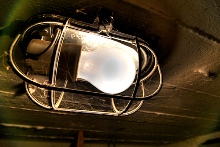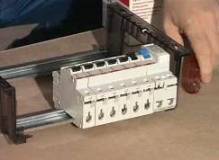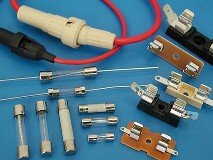How many insurers do you need to replace a light bulb?

Aichi Directors
One. His hands are tied behind his back, other departments hold him by the legs, and twist it clockwise, then against. And he unscrews the light bulb with his mouth.
Actuaries
One. He blows up a series of houses to calculate the likelihood that the shock wave will unscrew the old light bulb and insert a new one.
Underwriters
They will decide according to the Three-P Rule (floor, ceiling, finger). And the intervals will give the actuary.
Savers
The security guard does not change the light bulbs, he shoots them from the service weapon.
Accountants
How much the CFO will say, so much will change. But it’s necessary to clarify ...
About electrical protection devices for "dummies": residual current device (RCD)
 Imagine the following - a washing machine is installed in your bathroom. Whatever the well-known brand, devices of any manufacturer are subject to breakdown, and, say, the most banal thing happens - the insulation on the power cord is damaged and the network potential appears on the machine body. And this is not even a breakdown, the machine continues to work, but it is already becoming a source of increased danger. After all, if you touch both the car body and the water pipe at the same time, we will close the electric circuit through ourselves. And in most cases it will be fatal.
Imagine the following - a washing machine is installed in your bathroom. Whatever the well-known brand, devices of any manufacturer are subject to breakdown, and, say, the most banal thing happens - the insulation on the power cord is damaged and the network potential appears on the machine body. And this is not even a breakdown, the machine continues to work, but it is already becoming a source of increased danger. After all, if you touch both the car body and the water pipe at the same time, we will close the electric circuit through ourselves. And in most cases it will be fatal.
To avoid these terrible consequences, RCDs were invented - protective shutdown devices.
An UZO is a high-speed protective switch that responds to differential current in conductors that supply electricity to the protected electrical installation - this is the "official" definition. In a more understandable language, the device will disconnect the consumer from the mains supply if a current leakage occurs to the PE (ground) conductor. Let's consider the principle of operation of the RCD ...
How to make a simple status indicator of a remote lamp
 At one time, I was faced with the need to control the burning and integrity of the light bulb when the switch is in another room (for example, a basement, cellar or chicken coop). More than once it happened, the switch is turned on, and the light does not light up: it either burned out, or the contact in the cartridge or switch disappeared. In this case, the switch is located in the corridor, and to the basement, where hens live, you need to go around the house. It is especially bad when, because of this, the bird does not enter the basement in the evening, and then it must be entered manually. The problem was solved by installing a simple and trouble-free device that indicates the flow of current in the circuit of the lighting lamp and is located near the switch.
At one time, I was faced with the need to control the burning and integrity of the light bulb when the switch is in another room (for example, a basement, cellar or chicken coop). More than once it happened, the switch is turned on, and the light does not light up: it either burned out, or the contact in the cartridge or switch disappeared. In this case, the switch is located in the corridor, and to the basement, where hens live, you need to go around the house. It is especially bad when, because of this, the bird does not enter the basement in the evening, and then it must be entered manually. The problem was solved by installing a simple and trouble-free device that indicates the flow of current in the circuit of the lighting lamp and is located near the switch.
The indicator diagram is shown in the figure. When current flows through ballast diodes, a voltage sufficient for the LED to glow is incident on them. You can connect the device at any convenient point in the electrical circuit (before or after the switch) or to break the second wire leading to the lamp.
The indicator is not critical to details. As ballast diodes, you can use any small-sized diodes with a permissible direct current not lower than the illuminator current consumption and any operating voltage ...
In the near future, all power cables will be made of superconducting materials
 The flow of current in conductors is always associated with energy losses, i.e. with the transition of energy from electrical to thermal. This transition is irreversible, the reverse transition is associated only with the completion of work, as thermodynamics speaks of this. There is, however, the possibility of converting thermal energy into electrical energy and using the so-called thermoelectric effect, when two contacts of two conductors are used, one of which is heated and the other is cooled.
The flow of current in conductors is always associated with energy losses, i.e. with the transition of energy from electrical to thermal. This transition is irreversible, the reverse transition is associated only with the completion of work, as thermodynamics speaks of this. There is, however, the possibility of converting thermal energy into electrical energy and using the so-called thermoelectric effect, when two contacts of two conductors are used, one of which is heated and the other is cooled.
In fact, and this fact is surprising, there are a number of conductors in which, under certain conditions, there is no energy loss during the flow of current! In classical physics, this effect is inexplicable.
According to the classical electronic theory, the motion of a charge carrier occurs in an electric field uniformly accelerated until it collides with a structural defect or with a lattice vibration. After a collision, if it is inelastic, like a collision of two plasticine balls, an electron loses energy, transferring it to a lattice of metal atoms. In this case, in principle, there can be no superconductivity.
It turns out that superconductivity appears only when quantum effects are taken into account. It’s hard to imagine it. A slight idea of the mechanism of superconductivity can be obtained from the following considerations ...
About electrical protection devices for "dummies": circuit breakers
 Many people remember Soviet circuit breakers - plugs. Instead of ordinary ceramic plugs, they were screwed into the shield of an electric meter. It was a compromise solution, which, in general, paid off. Indeed, thanks to this, plugs became "reusable", and without changing the existing design of the electrical panel. In general, the inventor of automatic protection devices is ABB, which patented a small-sized circuit breaker in 1923. Much time has passed since then, but the principle of operation of the circuit breaker has remained unchanged - the restoration of its normal operation with one movement of the hand.
Many people remember Soviet circuit breakers - plugs. Instead of ordinary ceramic plugs, they were screwed into the shield of an electric meter. It was a compromise solution, which, in general, paid off. Indeed, thanks to this, plugs became "reusable", and without changing the existing design of the electrical panel. In general, the inventor of automatic protection devices is ABB, which patented a small-sized circuit breaker in 1923. Much time has passed since then, but the principle of operation of the circuit breaker has remained unchanged - the restoration of its normal operation with one movement of the hand.
A circuit breaker is an electrical switching device designed to conduct current in normal conditions and to automatically turn off electrical installations when short-circuit currents and overloads occur. The most common and popular today are circuit breakers that are mounted on a 35 mm DIN rail in a distribution panel.
The main parameter of circuit breakers is the rated current. This is a current whose value in a particular circuit is considered normal, i.e. for which electrical equipment is designed. For electrical installations in residential buildings, the rated current ...
How plants respond to electricity
 To begin with, the agricultural industry is completely destroyed. What's next? Is it time to collect stones? Is it time to unite all the creative forces to give the villagers and summer residents those new products that will dramatically increase productivity, reduce manual labor, find new ways in genetics ... I would suggest readers of the magazine to be authors of the heading "For the village and summer residents". I will start with the long-standing work "Electric field and productivity."
To begin with, the agricultural industry is completely destroyed. What's next? Is it time to collect stones? Is it time to unite all the creative forces to give the villagers and summer residents those new products that will dramatically increase productivity, reduce manual labor, find new ways in genetics ... I would suggest readers of the magazine to be authors of the heading "For the village and summer residents". I will start with the long-standing work "Electric field and productivity."
In 1954, when I was a student of the Military Academy of Communications in Leningrad, I was passionately carried away by the process of photosynthesis and conducted an interesting test with growing onions on the windowsill. The windows of the room in which I lived were facing north, and therefore the bulbs could not receive the sun. I planted five bulbs in two elongated boxes. He took the earth in the same place for both boxes. I had no fertilizers, i.e. the same conditions for growing were created. Above one box on top, at a distance of half a meter (Fig. 1), I placed a metal plate to which I attached a wire from a high-voltage rectifier + 10 000 V, and a nail was inserted into the ground of this box, to which I connected a “-” wire from the rectifier.
I did this so that, according to my theory of catalysis, the creation of a high potential in the plant zone will lead to an increase in the dipole moment of the molecules involved in the photosynthesis reaction, and the test days are drawn. Within two weeks I discovered ...
About electrical protection devices for dummies: fuses
 Fuses are designed to protect electrical networks from overloads and short circuits. They are very cheap and elementary simple in design. These devices are rightfully considered pioneers of circuit protection.
Fuses are designed to protect electrical networks from overloads and short circuits. They are very cheap and elementary simple in design. These devices are rightfully considered pioneers of circuit protection.
The fuse consists of two main parts: a body made of electrical insulation material (glass, ceramics) and a fuse (wire, metal strips). The outputs of the fuse-link are connected to the terminals, with the help of which the fuse is connected in series with the protected consumer or the circuit section. To do this, use special terminal holders. They must ensure reliable contact of the fuse - otherwise heating is possible in this place.
The fusible insert is selected so that it melts before the temperature of the line wires reaches a dangerous level or an overloaded consumer fails.
By design features distinguish between plate, cartridge, tube and plug fuses. The current strength for which the fuse is designed is indicated on its body. The maximum permissible voltage at which a fuse can be used is also specified.
The main characteristic of the fusible insert is the dependence of the time of its burnout on current. This dependency is the following graph ...
How to easily control a powerful AC load
 Sometimes you need a weak signal from the microcontroller to turn on a powerful load, such as a lamp in the room. This problem is especially relevant for smart home developers. The first thing that comes to mind is a relay. But do not rush, there is a better way :)
Sometimes you need a weak signal from the microcontroller to turn on a powerful load, such as a lamp in the room. This problem is especially relevant for smart home developers. The first thing that comes to mind is a relay. But do not rush, there is a better way :)
In fact, the relay is a continuous hemorrhage. Firstly, they are expensive, and secondly, to power the relay coil, an amplifying transistor is needed, since the weak leg of the microcontroller is not capable of such a feat. Well, and thirdly, any relay is a very bulky design, especially if it is a power relay, designed for high current.
If we are talking about alternating current, then it is better to use triacs or thyristors. What it is? And now I’ll tell you.
If on the fingers, then the thyristor is similar to a diode, even the designation is similar. Passes current in one direction and does not let in the other. But he has one feature that distinguishes it from the diode radically - the control input.
If the opening current is not applied to the control input, the thyristor will not pass current even in the forward direction. But it is worth giving at least a brief impulse, as it immediately opens and remains open as long as there is direct voltage. If the voltage is removed or polarity reversed, the thyristor will close ...
